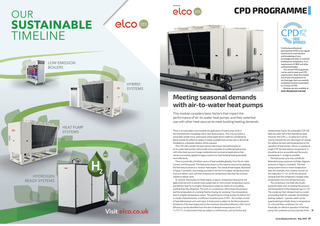


SPONSOR CPD PROGRAMME Continuing professional development (CPD) is the regular maintenance, improvement and broadening of your knowledge and skills, to maintain professional competence. It is a requirement of CIBSE and other professional bodies. This Journal CPD programme can be used to meet your CPD requirements. Study the module and answer the questions on the final page. Each successfully completed module is equivalent to 1.5 hours of CPD. Modules are also available at www.cibsejournal.com/cpd Meeting seasonal demands with air-to-water heat pumps This module considers basic factors that impact the performance of air-to-water heat pumps, and their potential use with other heat sources to meet building heating demands There is an inexorable move towards the application of heat pumps, both in the refurbishment of buildings and in new-build projects. This is by no means a universally simple move, particularly where applications might be considered as being outside the effective ranges of widely available heat pumps and, in almost all installations, a bespoke solution will be required. This CPD will consider the basic factors that impact the performance of air-to-water heat pumps, and provide some examples of combining heat pumps with other heat sources in larger residential and commercial applications that can be successfully applied to legacy systems to meet building heating demands more effectively. There is practically a limitless source of heat available globally, from the air, water courses, and the ground. The heat pump draws on this massive resource by applying the thermal processes of a reverse heat engine. The classical heat engine, illustrated in Figure 1 (overleaf), uses energy provided in the form of a higher temperature heat source to deliver work, and then exhausts low temperature heat that has not been utilised to deliver work. To reverse the process of a heat engine, a vapour compression heat pump will apply external work to extract lower grade heat QC from a lower temperature source and delivers heat QH to a higher temperature output by means of a circulating working fluid, the refrigerant. The work of a compressor will increase the pressure and the temperature of a working fluid by moving (or pumping) low temperature heat to a higher temperature output. The performance of heat pumps (to deliver QH) is usually characterised by a coefficient of performance (COP) the number of units of heat delivered per unit work input. A heat pump is subject to the thermodynamic limitations of the heat engine and so the maximum theoretical efficiency (the Carnot efficiency) can be identified from the ratio of absolute temperatures (in K) TH/(TH-TC). In real systems that are subject to inefficiencies, such as friction and radiative heat losses, the achievable COP will likely be under half of this theoretical value. However, the COPCarnot is useful as it can be used to interpret the pro rata impact of varying the relative hot and cold temperatures on the operation of heat pumps. Hence, to operate at a high COP, the heat delivery temperature TH should be as low as possible and the source temperature TC as high as possible. The heat pump cycle may usefully be illustrated using a pressure-enthalpy diagram, as shown in Figure 2 (overleaf). The heat pump system draws in lower temperature heat (for example, from outdoor cool air) at the evaporator (12), as the low pressure working fluid (the refrigerant) changes state (evaporates) into a low temperature gas. The compressor (normally electrically powered) adds work, increasing the pressure and temperature of the refrigerant gas (23). The condenser then releases heat to a cooler surrounding fluid (for example, the buildings heating medium typically water) as the superheated gas initially drops in temperature (33a) and then condenses (3a4). Practically, for effective operation of the heat pump, this condenser process typically limits www.cibsejournal.com May 2022 57 CIBSE May 22 pp57-60 CPD 196 ELCO Supp.indd 57 22/04/2022 15:57